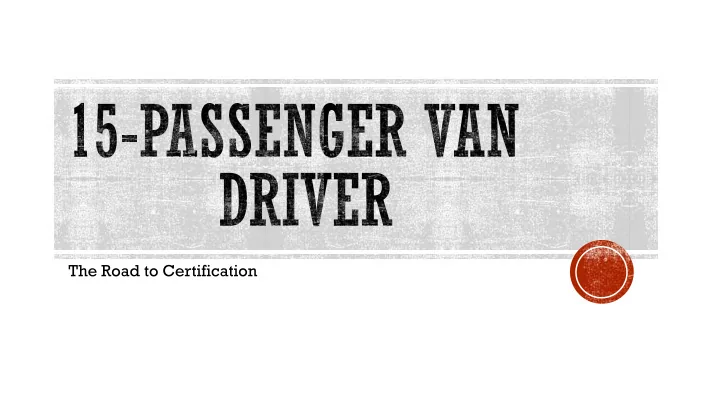

The Road to Certification
§ What you need to do to prepare for your on-road exam § Review this presentation § Be prepared to answer questions based on this presentation § Bring a copy of your current driver’s license § The on-road portion will last 30-40 minutes
1. Check the expiration date on your driver’s license 2. Visual inspection of the vehicle: 1. Fluid leaks under the van 2. Color of the fluid 3. Evaporative or oily? 3. Report any visible damage BEFORE you leave with the van 4. Check the tires of the van for a. Wear b. Proper inflation c. Objects protruding from the tire
1. Seat 2. Mirrors 3. Accessories-familiarize your self with the placement and operation of the various accessories 1. Turn signals 2. Gear Shift 3. 4-way flashers 4. Wipers and washers 5. Horn 6. Climate controls 7. Lights 8. Entertainment center
1. Proper loading; front to rear 2. Designate a co-pilot 3. Taller people sitting to sides 4. ALL passengers wearing seatbelts 5. Luggage and cargo secure 6. A loaded van changes handling characteristics
Don’t stop unless warning bells and gate are activated • Use caution; slow down with foot over brake pedal • When stopped at a RR crossing, put van in PARK • Look left, then right, then left again before proceeding after gate lifts or bells stop • Never try to beat a train to a crossing • NEVER drive around a crossing gate • Trains are moving faster than they appear and they CAN N OT stop! •
Vans have a larger turning radius than standard automobiles • Check mirrors while making turn to insure clearance • There should be a 4-second space between you and the car in front • Add 2-seconds for variables (rain, reduced visibility, etc.) • Vans have an increased stopping distance: • At 55 mph, it takes 270’ to bring van to a safe stop • At 70 mph, it takes 390’ to bring van to a safe stop • This distance will increase depending on road conditions and load •
Co-pilot should operate accessories and entertainment controls • If you don’t have a co-pilot, pull over before making adjustments • You should not engage in cell phone conversations while driving the van • NEVER TEXT WHILE DRIVING! • Rest stop every two hours • Drive during daylight hours when possible •
Signal early; look over left shoulder; check front; look again; change smoothly Readjust spacing Use co-pilot if possible to change lanes to the right
Always load passengers front to rear and secure all cargo Reduce distractions If you drive off the shoulder, do not panic. Foot off the gas; gradual stop. 90% of all rollovers happen because drivers overreact Percentage increases with the number of passengers and amount of cargo
ALWAYS use a spotter Park in a pull-through whenever possible Unload passengers in a safe location, then back into space aligning left using a spotter Use outside mirrors If you pull in frontwards, use a spotter to back out before loading passengers
Recommend
More recommend